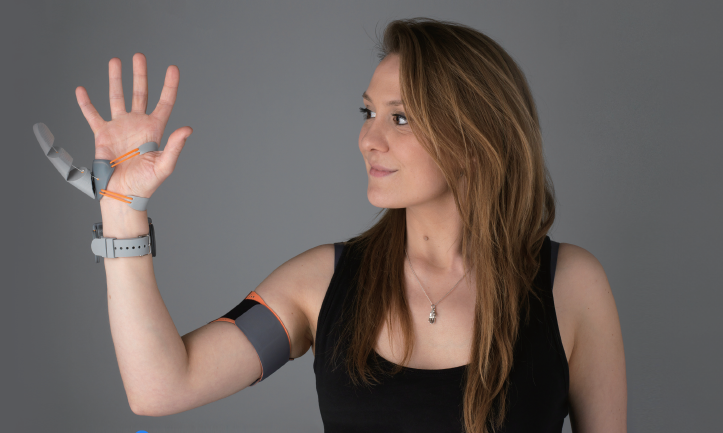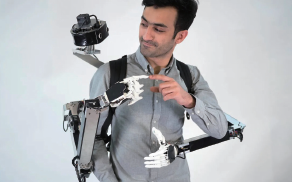
Easy to operate robot thumb for children and adults
Professor Tamar Makin and his research team at the Cognitive Neuroscience Laboratory at the University of Cambridge in the UK recently announced in the international academic journal 'Science Robotics' that "they have experimentally proven that anyone, regardless of age or gender, can easily use a third robotic thumb mounted on the hand."
The researchers called it a third thumb because it added a robotic thumb to the original thumbs on both hands. A person wearing the robotic thumb was able to open a water bottle with one hand and peel a banana. He was also able to hold a coffee cup with one hand and stir it with a spoon. He was also able to hold four tangerines, which he could normally only hold three.
The researchers first published the robotic thumb in the same journal in 2021. What’s interesting is that the robotic finger operates as a toe. The robotic finger has a sensor that receives wireless signals and directs movement. This sensor is wirelessly connected to a device worn on the ankle. The ankle device in turn receives signals from a pressure sensor attached to the big toe.
The robotic thumb works by following the movement of the big toe. When you apply force to the big toe of your right foot, the pressure sensor detects the force and causes the robotic thumb to close. Conversely, when you press the big toe of your left foot, the robotic thumb opens. The force of the grip and opening varies depending on how much you press the toe.
Researchers at the University of Cambridge tested robotic thumbs on people of all ages at the Royal Society's Summer Science Exhibition in 2022. The researchers made the robotic thumbs different sizes according to age. Of the 596 people, ranging in age from 3 to 96, only four were unable to operate the robotic thumb. They were either too young for the robotic thumb to fit or had difficulty operating it with their toes. The remaining 98% were able to pick up objects with the robotic thumb in just one minute.
“Augmentation is about creating something that is more than just a tool, it’s an extension of the body itself,” said Dani Clode, who designed the robotic thumb. “It has to be easy and fast for people to use.” The researchers say the robotic thumb could be especially useful for someone who has lost an arm, because one hand can do more than before.

Remotely control a robot arm that is attached to a worker's back
In the Marvel movies, Doctor Octopus overpowers Spider-Man with his four robotic arms. The imagination of the movies has become reality. In August 2018, researchers at Keio University in Japan presented the 'Fu-sion', a robotic arm system that can be carried on the back like a backpack, at SIGGRAPH, the world's largest computer graphics exhibition held in Vancouver, Canada. The robotic arm operates by watching the work situation through a camera over a person's shoulder and then picking up and delivering the tools requested by the person.
Fusion is remote-controlled. The robot attached to the agent’s back transmits images and sounds from the scene through cameras and speakers to the remote operator’s virtual reality (VR) headset. This allows the remote operator to control the robot arm while looking around from the agent’s perspective. For example, the operator can watch the agent’s work and move the robot arm to help with the task.
By attaching a robotic arm to the agent's arm, it is also possible to remotely control the person's actions. The researchers said, "A rehabilitation therapist can wear a VR headset and move the patient's arm connected to the robotic arm to perform rehabilitation training." Similarly, an agent can work under the direction of a robotic arm controlled by an expert at a disaster or rescue site.

It can also be used in industrial settings. Researchers at the Massachusetts Institute of Technology (MIT) in the United States have developed a robot arm called Octo that can be carried on one's back. The aircraft manufacturer Boeing provided research funding. The researchers explained that the robot arm can support heavy aircraft parts and workers can safely assemble them underneath. Researchers at the Advanced Telecommunications Research Institute (ATR) in Japan controlled the robot arm mounted on one's back using brain waves. When it was thirsty, it brought a straw stuck in a drink to its mouth.
Attached robotic fingers or arms can not only increase work efficiency, but can also be used to help with the rehabilitation of the disabled or work at disaster sites. Dr. Oh Yong-hwan of the Intelligent Robotics Research Group at the Korea Institute of Science and Technology (KIST) said, “Having more robotic fingers or arms on the body would be helpful in terms of expanding and extending human functions,” adding, “It could be a very useful device for people with inconvenient fingers or arms, as one person could do the work of two people.”
However, Dr. Oh said, “In order for people to feel like their own robotic fingers or arms are their own, they need to be able to move comfortably, and more research is needed on transmitting and receiving tactile sensations to the external environment or objects.” If research continues to advance as it is now and solves the problem, it may not be long before a world where a robotic hand with added robotic fingers or a “Nepal” with two robotic arms is normal. It’s just a shame that Leslie Cheung can’t see that world.